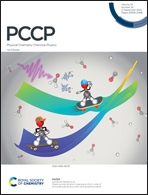Carbon-doped anatase titania nanoparticles: similarities and differences with respect to bulk and extended surface models†
Abstract
C-Doping of titania nanoparticles is analyzed by using all-electron density functional theory-based calculations considering the (TiO2)84 nanoparticle as a realistic representative of nanoparticles in the scalable regime. Several sites are evaluated including substituting oxygen (CO) and titanium (CTi) sites as well as interstitial (Ci) situations. The formation energy of such a doped structure is studied as a function of the oxygen chemical potential (or oxygen partial pressure). Our calculations predict that low partial oxygen pressure favors the formation of C-doped (TiO2)84 NPs at oxygen and interstitial sites. For the former, the most stable situation is for O sites at the inner part of the nanoparticle. Interestingly, the substitution of O by C at facet sites requires formation energies as those reported in previous studies where the bulk anatase and surfaces models were considered. However, C-doping – at other low coordinated sites not presented in extended models – is even more favorable which shows the need to employ more realistic models for nanostructures involved in photocatalytic processes.



 Please wait while we load your content...
Please wait while we load your content...